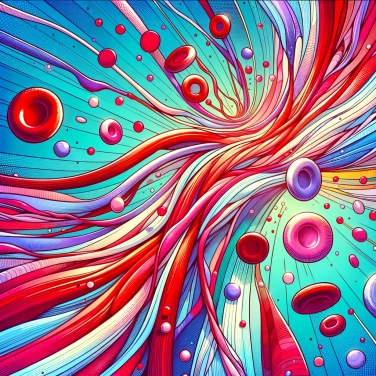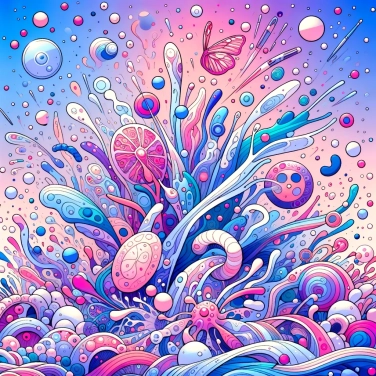Blood is red due to the presence of hemoglobin, a protein found in red blood cells, which carries oxygen. When hemoglobin binds to oxygen, it takes on a bright red color.

The red color of blood mainly comes from a pigment called hemoglobin, an essential component of red blood cells. This pigment contains iron, which gives that famous bright red hue when it binds to oxygen: it's a bit like rust, but much better organized! Basically, the more oxygen the hemoglobin carries, the more vibrant the blood is. Besides hemoglobin, there are other pigments, like myoglobin, which is found mainly in muscles and has a similar role. Then, in some animals (not in us, sorry!), blood can even be a different color due to different pigments (like blue hemocyanin in some mollusks, for example).
When you inhale, oxygen enters your lungs and attaches to molecules called hemoglobin present in your red blood cells. This hemoglobin has the unique characteristic of being a true taxi for oxygen; it picks it up in the lungs until saturation, then circulates throughout your body via the blood. Upon reaching its destination, in your muscles or organs for example, it releases its oxygen to nourish your cells. Once the oxygen is released, hemoglobin picks up carbon dioxide (CO₂), a waste product produced by your cells, to bring it back to your lungs for elimination when you exhale. The bright red color of oxygenated blood comes directly from this bond between oxygen and the iron contained in hemoglobin. Without this process of pick-up and delivery, it would be impossible for your body to function properly!
When light passes through your skin, it encounters the hemoglobin in your blood. This molecule absorbs certain colors of light more easily than others. Specifically, it loves to absorb blue and green light, but not really red. As a result, red is the color that stands out the most and that your eye easily captures. Even better: when hemoglobin carries plenty of oxygen (it is then said to be oxygenated), its structure changes slightly and alters its ability to absorb colors. This is what gives it that beautiful bright red color, which you see for example when you get a slight cut or when you are out of breath after running. When hemoglobin loses its precious supply of oxygen, it becomes darker, giving your veins that deeper hue that is sometimes visible just under the skin. The light-hemoglobin interaction explains why sometimes your blood appears bright red, and other times darker.
Blood can vary in hue depending on the amount of oxygen it carries. When it is oxygen-rich, it takes on a bright red and vibrant color. In contrast, when it is less oxygenated, it adopts a dark shade, almost burgundy or purplish. If you see very dark blood, there’s usually no immediate cause for concern: it is often just a matter of exposure to air, but sometimes it can be a sign of a lower oxygen level. Substances like certain medications or poisonings can also change the color of the blood to a brownish or even bluish (though that is quite rare). Some rare diseases also alter its pigmentation, sometimes making it chocolate brown (as in methemoglobinemia), or even slightly greenish in extremely rare cases.
Once exposed to air, human blood turns a brownish or dark color; this is the result of the oxidation of the pigments present in hemoglobin.
Did you know that about 7% of your total body weight corresponds to the weight of your blood? Therefore, a person weighing 70 kg has approximately 5 liters of blood.
Blood plasma, the liquid part of blood, makes up about 55% of blood volume and is mainly composed of water, proteins, and mineral salts.
Veins, although appearing blue through the skin, do not actually carry blue blood. This bluish appearance is due to the absorption and reflection of light by our skin.
When blood dries, hemoglobin deteriorates and loses some of its oxygen. This oxidation causes a chemical change that darkens the blood pigment, making it appear dark brown or almost black, instead of the bright red seen when it is fresh and oxygenated.
Oxygen-rich blood (arterial) has a bright red color because hemoglobin is strongly bound to oxygen. In contrast, when hemoglobin loses its oxygen at the tissue level, its color shifts to a darker red, giving venous blood a darker appearance.
Veins appear blue under the skin due to how the skin and subcutaneous tissues filter light. Venous blood is darker and low in oxygen, and the reflected light penetrates the skin in a way that visually creates this bluish hue. However, the blood remains red, whether it flows through an artery or a vein.
In most vertebrates, such as mammals, birds, and reptiles, blood is red due to hemoglobin. However, some marine animals like octopuses, crustaceans, and squids have different pigments such as hemocyanin, which makes their blood blue, or chlorocruorin, which gives a greenish tint to certain marine worms.
In general, human blood is red due to the presence of hemoglobin. However, under certain specific conditions, it can appear darker, almost brownish, or conversely very light, depending on its oxygenation or in the case of certain medical conditions. Nevertheless, blood does not naturally become blue or green, contrary to some popular beliefs.

0% of respondents passed this quiz completely!
Question 1/5